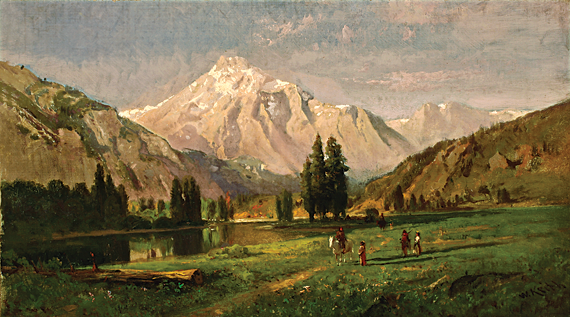
This painting by Keith from the 1870s or early 1880s shows a scene depicted from Tuolumne Meadows in California's Yosemite National park. During this time he travelled around Yosemite with John Muir, an early advocate of the preservation of wilderness in the United States. It was well known in this period when he travelled that Keith 'felt free to depart from geologic reality, placing an imagined glacier or a river in a scene to enhance the beauty of the painting' and so this painting may be slightly altered from the reality of what he saw to obtain awe from the viewer. The great variety in landscape in only one area, how it can go from flat ground with a lake, to hills, and then to mountains exemplifies the great variety of the West in general. His use of people and a horse in the foreground to allow the vast scale and size of the West to be put into perspective, with the valley creating lines so that your eye travels to the mountain range in the background. Furthermore, the use of light in this painting to make the mountains and sky seem bright whilst the foreground is shadowy and warmer that gives the painting a sense of calm and safety and that this wilderness is in fact as safe and welcoming as it is picturesque. Therefore this painting, much like many of his contemporaries when he studied art in Germany, could be seen as a product of Romanticism in art in this period of settlement.
It is perhaps unusual that humans are depicted in this painting, as they are often omitted to portray the wild landscape as untouched by human intervention; but in this case they are seen as entirely peaceful and gives the painting a sense of adventure in such a place of natural beauty as they are merely observing. There is no sense of danger and no wild animals are seen. This links to his agenda to show the West in a way that portrays its need to be preserved.
No comments:
Post a Comment